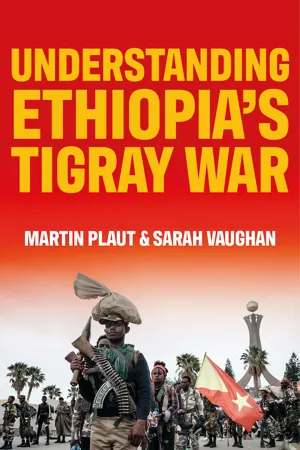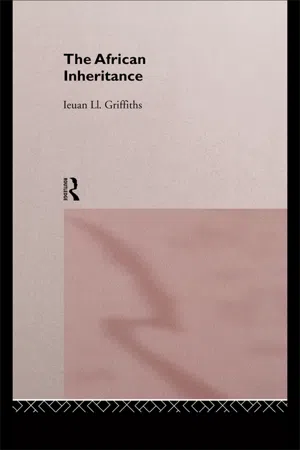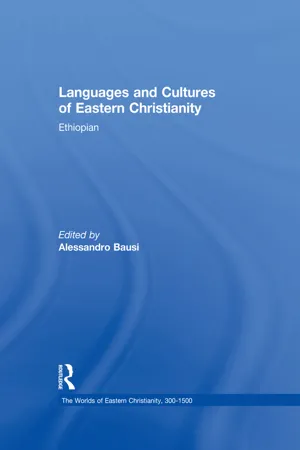History
Ethiopian Empire
The Ethiopian Empire, also known as Abyssinia, was a monarchy that existed from the 12th century until 1974. It was one of the few African countries to resist European colonization, maintaining its independence through strategic alliances and military strength. The empire's rich history is characterized by its unique blend of Christianity, indigenous traditions, and resistance to external influence.
Written by Perlego with AI-assistance
Related key terms
6 Key excerpts on "Ethiopian Empire"
- eBook - ePub
- Martin Plaut, Sarah Vaughan(Authors)
- 2023(Publication Date)
- Hurst Publishers(Publisher)
3 The historical reality is, of course, more complex and episodic. There is little or no historical evidence of a continuity of polity, or of royal lineage, between the period of the Axumite Empire, which seems to have ended in the seventh century CE, and the emergence of the modern Ethiopian Empire state after the mid-1850s.From the third century CE Axum emerged as a major power, controlling land to the Red Sea and trade beyond. David Phillipson situates the elusive kingdom in socio-economic developments across the northern Horn of Africa between 3,000 and 700 years ago, preceding (possibly by a gap of several centuries) two later Ethiopian dynasties:4 the Agaw Zagwe dynasty at Roha (later Lalibela, in what is now the north-east of Amhara region) from sometime after 900 CE; and a series of kings from further south, later associated with the region of Shewa (also now part of Amhara), who superseded the Zagwe in 1270 CE. The ‘Axumite civilisation’ evolved several centuries earlier, and over a much wider geographical area, than its period of ‘political hegemony’, but relatively little is known of the earlier and later phases. Much historical and archaeological work remains to be done, particularly on the later period as the empire declined. These uncertainties have made the Axumite Empire the perfect cipher onto which later nationalist histories have been projected. The conflation of the Axumite Empire with the romantic narrative of the mythical ‘Queen of Sheba’, and her legendary visit to King Solomon’s Jerusalem, further embellished later cycles of myth making.5Axum’s lucrative trade in local elephant ivory (from the lowlands north and south of the Tekeze River) helped it emerge as a significant socio-economic power during the early Roman Empire. By the second half of the third century CE, Axum had grown into a wealthy power holding sway over a growing area—although the evidence of archaeological sites, oral tradition and stone inscriptions is remarkably inconclusive. Archaeological references to the Beja (now in Sudan east of the Nile), to the Hamassien plateau around the Eritrean capital Asmara, to Adulis on the Eritrean coast, and to Simien and Welkaiyt to the south-west are plausible but not definitive.6 - eBook - ePub
Some Records of Ethiopia, 1593-1646
Being Extracts from The History of High Ethiopia or Abassia by Manoel de Almeida Together with Bahrey's History of the Galla
- G.W.B. Huntingford, C.F. Beckingham(Authors)
- 2017(Publication Date)
- Hakluyt Society(Publisher)
Africa and eventually became dominant there. ‘Abyssinia’ is derived from this through such forms as Abasēnoi, used by Stephanus of Byzantium (c. A.D. 410). 1 ‘The real reason why Ethiopia is called Abassia and the Ethiopians Abyssinians is that that word means a free and independent people (in Arabic, Turkish and the language of the Ethiopians), who had never recognised a foreign king; such is the land of Ethiopia, as we shall relate’ (Urreta, p. 4). This is nonsense, but the old national name Ge’ez, which is still applied to the Ethiopic language and which originally meant ‘migratory’ can also mean ‘liberated’, ‘manumitted’ and hence ‘free’. CHAPTER 2 What countries and kingdoms are comprised in the Ethiopia which we are considering, and what part of it is controlled by the Emperor of the Abyssinians Ethiopia is a general term and so includes both eastern and western Ethiopia. 2 The sacred writers call eastern Ethiopia the land of Madian, which is between Arabia and Palestine, beyond the Red Sea. Western Ethiopia includes a large part of Africa because writers use this name for all the land that runs out from Egypt along the Red Sea, and beyond the gateway to this sea, all that extends not merely as far as Cape Goardafuj, but to the Cape of Good Hope, and after doubling that, all the land there is as far as Angola and Cape Verde. We call all the inhabitants of these coasts and of the interior behind them Ethiopians. The geographers, however, divide Africa into five parts and restrict the limits of Ethiopia proper, taking from it the part they call in Latin Nigritarum regionem, which we in Portuguese call Cafraria. 1 Nevertheless, even in the geographers’ way of speaking Ethiopia includes all that there is from Egypt to Cape Goardafuj and thereafter much further on to Melinde and Mombaça - eBook - ePub
- Kidane Mengisteab(Author)
- 2013(Publication Date)
- Polity(Publisher)
Unlike the Abyssinian empire, which was re-established by conquering other kingdoms, the Mahdiya state (1881–98) was formed by defeating an oppressive foreign rule, the Turkish–Egyptian rule. Present-day Sudan came under the Ottoman rule in 1820, when the Ottoman empire's viceroy in Egypt, Muhammad Ali, expanded the empire southwards. Mohammad Ali's troops defeated the various kingdoms in the Sudan and extended the empire into Central Africa. The Mahdiya state was established through a revolt against the Turkiya empire, which placed upon its subjects an oppressive tax system. The Mahdiya state, however, lasted less than two decades, as it fell prey to an Anglo-Egyptian colonial expedition in 1898. By contrast, the Abyssinian empire was able to maintain its independence by defeating an Italian colonization effort in 1895 in the well-known battle of Adwa.Unlike the decentralized political systems, the kingdoms and empires have left behind socioeconomic contexts that still foster inter-state and intra-state conflicts. The various wars and conquests of kingdom formation and empire-building as well as the political, economic and cultural relations that were left by the empires have left behind notable socioeconomic contexts that still have some lingering effect on nation-building. Among the specific contexts they left behind are the scars from the violence, looting and most importantly, slave raids, enslavement and slave trade. Both the Abyssinian empire and the Mahdiya state engaged in slave trade and the destructive raids involved. As Reid (2011) notes, these empires encountered endless wars of resistance from marginalized identities’ frontier regions, which often were subjected to looting and plunder. Many of the kingdoms in the region also utilized slave labour and were involved in slave trade. The Oromo kingdoms in the southern parts of Ethiopia, such as Jimma, were slave traders. Kings and nobles in Jimma and other kingdoms in the Gibe and Didessa valleys possessed estates worked by thousands of peasants and large numbers of bonded labourers. In Jima, for example, the monarch, Abba Jifar II, is said to have possessed as many as 10,000 slaves and wealthy men commonly owned more than 1,000 slaves (Fernyhough, 2010: 75). There were also some 80,000 slaves in the kingdom of Keffa in 1897 (Fernyhough, - eBook - ePub
- Ieuan Ll. Griffiths(Author)
- 2005(Publication Date)
- Routledge(Publisher)
The Christian empire of the Prester John was known to Europe before European navigators rounded the Cape and opened up the Cape sea route to India at the end of the fifteenth century. The Prester John had sent representations to his fellow Christian King of Portugal who regarded him as an equal and an ally in the fight against Islam. Also an ally well placed for a potentially lethal strategic strike at the Islamic underbelly. Such military fantasies did not materialize but Abyssinia (Ethiopia) was always treated as an imperial equal, an ally to be assisted, a normative political entity.During the nineteenth-century European partition of Africa, Ethiopia was again regarded by the European powers as their equal in imperialism. The aggressive imperialism of the Emperor Menelik in extending his territory at the expense of his neighbours in the 1880s and 1890s was accepted by the European powers and it was not until the Italians belatedly entered the ‘scramble’, in desperation for an empire, that Abyssinia was really threatened. In 1896, at the battle of Adowa, the Italians were comprehensively defeated and retired to their Red Sea colony to lick their wounds and nurture their grandiose imperial ambitions for forty years. Italian fascism in the 1920s and 1930s yearned for an empire to demonstrate its political virility. With the appeasing connivance of Britain and France, who with the infamous Hoare-Laval pact opened the Suez Canal to the Italian imperial force, Abyssinia was targeted. Deploying modern armaments, the Italians quickly won the war, and the short-lived Italian East African Empire created in 1936. Abyssinia’s colonial experience in Italian hands was for five years only before being liberated by British and Commonwealth (South African, Nigerian and East African) forces who entered Addis Ababa after a lightning advance on 6 April 1941. Haile Selassie was back on his throne five years to the day after having to flee his capital before the Italian invasion.Defeat by imperialism and exile had not spoiled Haile Selassie’s imperialist appetite. Ethiopian imperialism went on to outlast direct European imperialism in Africa, and despite dramatic changes in its domestic political ideology Ethiopia was until 1991 a loosely-knit empire which had not succumbed to the forces of disintegration which had devastated much grander empires elsewhere. The main victim of post-war Ethiopian imperialism was Eritrea, but other parts of the empire, including Tigray in the north and the Ogaden in the east, have fought militarily for greater autonomy if not outright secession. - Alessandro Bausi(Author)
- 2017(Publication Date)
- Routledge(Publisher)
1 Perspectives on the History of Ethiopia 1Enrico CerulliEstablishing facts through research and the analysis of the documents and traditions is without any doubt the essential and necessary preliminary work of the historian. Thus even the account of single events that succeeded each other in time and of the action of single individuals is an important prerequisite to the writing of history. From those premises and those prerequisites, however, the historian must depart, or rather elevate himself to consider and appreciate what a particular period or a particular country - in space and time - represent in terms of value to the entire ebb and flow of human history. So today I would rather not dwell on the reconstruction of the events of Ethiopia's very rich history, nor do I propose to present you with new documents; I shall rather highlight some fundamental themes, which have driven and stimulated the history of that African country.Ethiopia is indeed African geographically, but - and I insist here on ideas that I have expressed elsewhere - it is true that the African theme has had less importance than others in Ethiopian history. This is in part a result of the physical shape of the Ethiopian plateau, projected towards Asia along the Red Sea and the Gulf of Aden and, in its central and southern part, on the contrary, precipitously overhanging the formerly unhealthy valley of the tributaries of the Middle Nile.May I add, to better clarify the contours of my argument, that here I shall not consider Ethiopia ethnically, nor discuss prehistoric and protobistorical Ethiopia, but will focus on the Ethiopian state and the causes of its formation and its early structural and cultural development.Here is a first powerful theme in Ethiopian history: the immediate proximity of the country to the Arab Peninsula and its relations with the Arabs, especially those of the South. Indeed, the first Ethiopian state sprang along the Erythraean coast, and then developed along the front spur of the plateau - I mean from Adulis, the port, to Aksum, the capital - as a consequence of the migration of southern Arabs who brought their language, their culture, their organisation and their enterprising spirit from the renowned lands of Saba to the African coast facing them.- eBook - ePub
Collision of Empires
Italy's Invasion of Ethiopia and its International Impact
- G. Bruce Strang(Author)
- 2016(Publication Date)
- Routledge(Publisher)
The truism that weak states are most likely to look to international laws, conventions and institutions for their survival has obvious relevance in the Ethiopian crisis. Political leaders in all countries are aware that the history of a political realm is often characterized by the disappearance or subversion of states. Even in the context of interwar Europe, Ethiopia was politically and militarily weak. As we shall see, in the years prior to the crisis, the Ethiopian Emperor Haile Selassie sought to exploit not only the domestic but also the international institutions which he hoped would safeguard his rule and permanently establish Ethiopia as a recognized state. The tragedy of the Ethiopian crisis is to be found in the incompatibility of two objectives: beyond a certain point, the concessions made to accommodate Italy compromised the credibility of the League and the plausibility of collective security on which Ethiopia depended.The invasion was a disaster for Ethiopia, marked as it was by the brutality of Italy’s invading forces, the use of asphyxiating gases causing widespread suffering and death, and the destruction of many of Ethiopia’s churches and holy places. Prior to the attack, Ethiopia’s future was portrayed in apocalyptic terms. As Josef Israels wrote for the New York Times, ‘the Ethiopian Empire, last stronghold of monarchy in Africa, is now engaged in what will probably be a life-or-death struggle for an independent existence’.1 In fact there were also other longer-term changes that were taking place in the international system that would eventually help sustain weak states in Africa and elsewhere. While the Italians were defeated by the British, post-war Ethiopia would be among the first of what Robert Jackson has referred to as ‘quasi-states’: states that existed and survived primarily on a juridical or legal rather than empirical basis.2
Learn about this page
Index pages curate the most relevant extracts from our library of academic textbooks. They’ve been created using an in-house natural language model (NLM), each adding context and meaning to key research topics.





